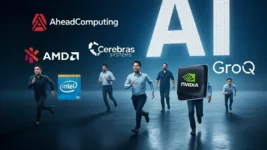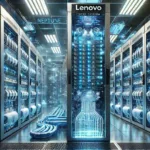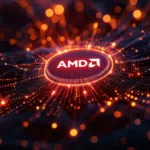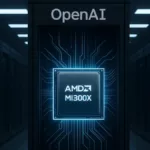The artificial intelligence (AI) revolution is reshaping the very bedrock of computing, promising a future that is as exhilarating as it is uncertain. While AMD, Intel and NVIDIA currently dominate the semiconductor headlines, a deeper look reveals that despite their individual strengths – AMD’s burgeoning open-source leadership, Intel’s enduring processor market share and NVIDIA’s current GPU supremacy – all three face existential threats. These challenges could see them being bypassed by a new breed of AI-forward companies and potentially relegate them to the annals of “has-beens” if they don’t adapt with unprecedented speed and vision. After all, history is littered with former champions who failed to navigate the next technological tidal wave.
The Peril of Pioneering: When Front-Runners Falter
NVIDIA, having largely ignited the current AI craze with its powerful GPUs and proprietary CUDA software, stands as the undisputed king of AI accelerators. Its market share for GPUs is formidable, with NVIDIA commanding around 92% of the GPU market share in Q1 2025 and approximately 80% of the AI accelerator market.
However, history teaches a harsh lesson: It’s rare for companies at the very front end of a disruptive technological wave to maintain their dominant position until the technology stabilizes and becomes mainstream. This phenomenon, described in Clayton Christensen’s The Innovator’s Dilemma, occurs because established leaders focus on serving their existing high-margin customers and are often slow to adapt to disruptive, lower-margin innovations that eventually capture the mainstream. Think of Nokia. It was once the mobile phone titan that famously failed to pivot to smartphones, clinging instead to older technologies while Apple and Samsung surged ahead. Or IBM, which, despite inventing the PC, ultimately abandoned the PC market after missteps like the ill-fated PCjr instead of owning the personal computing revolution it started. NVIDIA’s proprietary CUDA ecosystem, while a current strength, could become its Achilles’ heel if the AI market increasingly demands open standards and more flexible solutions.
The Big Three’s Unique Vulnerabilities
Each of these semiconductor titans carries its own unique baggage into the AI future:
- Intel: Despite maintaining the lion’s share of the overall x86 CPU market (around 75.6% in Q1 2025), Intel faces immense pressure from its manufacturing challenges, the rise of powerful AI accelerators from competitors and the significant trend of cloud companies designing their own custom processors like Amazon (Graviton), Google (TPU) and Microsoft (Cobalt).
- NVIDIA: While still the king of AI GPUs, its proprietary CUDA platform presents a vulnerability. The market is increasingly leaning towards open-source alternatives like AMD’s ROCm, which offers greater flexibility and less vendor lock-in. If the industry coalesces around open standards, NVIDIA’s closed ecosystem could become a significant competitive disadvantage.
- AMD: Despite its strong momentum in open-source AI (ROCm™ software stack is getting updates every two weeks and ROCm 7 is coming) and competitive hardware performance (Instinct MI325X outperforms NVIDIA H200 in Llama 2 fine-tuning), AMD is still fighting for market share against two entrenched giants. It faces the challenge of scaling its ecosystem and convincing a historically NVIDIA-dominated AI development community to switch.
The Rise of the AI-Native Challengers: Beyond the Big Three
The true disruptive force might not come from within this established trio. A new wave of “AI-forward” companies is emerging, unburdened by legacy architectures or entrenched business models. These startups, often with open-source roots, are designing solutions from the ground up specifically for the unique demands of AI. For example, AheadComputing, founded by former Intel CPU architects, is focusing on high-performance RISC-V processors for AI, cloud and edge devices, highlighting the limitations of current architectures for modern AI workloads. Other examples include Cerebras Systems, known for its wafer-scale engine for massive AI model training, and Groq, focusing on ultra-low-latency AI inference.
Perhaps the most potent threat comes from the recently announced merger of Jony Ive’s design powerhouse, IO, with OpenAI. This alliance aims to develop entirely new AI-powered consumer devices, potentially rendering most existing PC and even smartphone computing hardware obsolete. Imagine a device where the AI is the interface, transcending traditional screens and operating systems. This could bypass the need for conventional CPUs and GPUs as we know them, creating a completely new computing paradigm.
A “Skunk Works” Solution: Reclaiming the Edge
To avoid being relegated to the sidelines, AMD, Intel and NVIDIA all need to cultivate a “skunkworks” mentality – small, autonomous and highly innovative teams operating outside traditional corporate bureaucracy. These projects should focus on:
- Radical AI-Native Hardware: Developing completely new chip architectures designed from the ground up for AI, potentially embracing open hardware designs.
- Pure Open-Source Software Ecosystems: Investing heavily in building truly open and collaborative software platforms that attract the broadest possible developer community.
- Deep Integration with AI Models: Moving beyond selling chips to offering full-stack, optimized solutions for specific AI workloads and applications, potentially even partnering with leading AI model developers in new ways.
- Exploring Post-PC/Smartphone Paradigms: Actively researching and investing in the next generation of computing devices that might emerge from the AI revolution, beyond the confines of current form factors.
Wrapping Up: The Imperative of Adaptation
The AI revolution presents an existential challenge to the semiconductor industry’s established order. While AMD, Intel and NVIDIA all possess immense talent and resources, their traditional business models and proprietary leanings could become liabilities in a landscape increasingly defined by open-source collaboration, custom silicon and radical new hardware concepts. History is replete with examples of industry leaders who failed to adapt to seismic technological shifts. To avoid becoming cautionary tales, these giants must shed their corporate inertia, embrace a more agile, experimental approach and perhaps even collaborate in unconventional ways to build the truly open, AI-native computing future that is rapidly taking shape. The time for incremental change is over; the future demands a revolutionary response.








